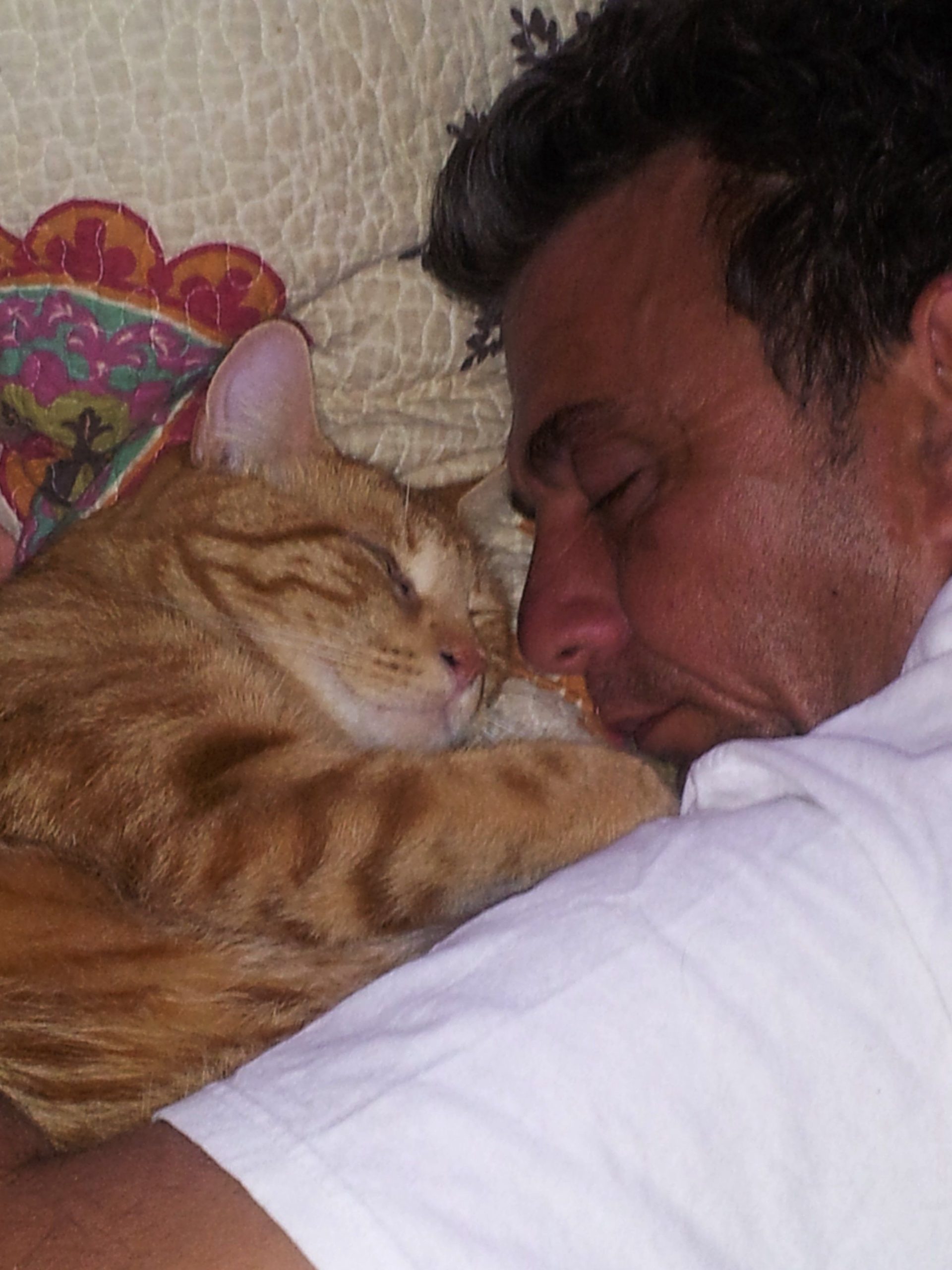Contents
- I. Introduction
- II. The Concept of Dominance in Cat Behavior
- III. Biting a Cat’s Ear: A Dominance Behavior?
- IV. Understanding Cat Communication
- V. Signs of Dominance in Cats
- VI. Myths and Misconceptions about Dominance in Cats
- VII. Frequently Asked Questions about Cat Behavior and Dominance
- 1. Are cats naturally dominant animals?
- 2. What are some signs of dominant behavior in cats?
- 3. Is biting a cat’s ear a display of dominance?
- 4. Can dominance be a factor in cat-human interactions?
- 5. How can I establish myself as the dominant figure with my cat?
- 6. Can dominance behavior in cats be modified?
- 7. Are male cats more dominant than female cats?
- 8. Should I intervene when cats display dominant behavior towards each other?
- 9. Can a cat’s dominance affect its overall well-being?
- 10. Should I consult a professional if my cat displays dominant behaviors?
I. Introduction

Welcome to the intriguing world of feline behavior! Cats have always been fascinating creatures, and their actions often leave us wondering what they really mean. One such behavior that sparks curiosity is when a cat bites another cat’s ear. Many people believe that this behavior indicates dominance, but is that really the case? Let’s dive deeper and unravel the truth behind this phenomenon.
Understanding Feline Communication
Before we tackle the concept of dominance, it’s crucial to understand how cats communicate with each other. Unlike humans, cats primarily use body language and vocalizations to convey their emotions and intentions. Tail movements, ear positions, vocalizations, and even facial expressions play a significant role in their communication repertoire.
The Purpose of Ear Biting
When a cat bites another cat’s ear, it’s important to consider the context and the overall body language of the cats involved. Ear biting can occur during play sessions, especially among kittens who are learning social skills. It’s a way for them to establish boundaries and communicate during their playful interactions.
In some cases, ear biting can also occur during more intense or aggressive encounters. However, it’s crucial to note that this behavior alone does not necessarily indicate dominance. Dominance in cats is a complex concept that involves various factors such as resource control, territory, and social hierarchy.
Other Factors to Consider
When analyzing cat behavior, it’s essential to consider the individual personalities of the cats involved, their past experiences, and the overall dynamics within their social group. Cats have unique temperaments, and their interactions can be influenced by factors such as fear, stress, and even previous encounters.
It’s also worth mentioning that cats can engage in behaviors that mimic dominance without actually being dominant. Some cats may exhibit assertive behaviors to protect their resources or assert their boundaries, but this doesn’t necessarily mean they hold a dominant position in the social hierarchy.
Conclusion
II. The Concept of Dominance in Cat Behavior

Understanding the concept of dominance in cat behavior is essential for cat owners to establish a harmonious relationship with their feline companions. While it is commonly believed that biting a cat’s ear is a display of dominance, the truth behind this behavior is more complex and multifaceted.
The Nature of Dominance
Dominance in cat behavior refers to the hierarchical social structure that exists within a group of cats. It determines the social order and the distribution of resources, such as food, territory, and attention. Cats establish dominance through a combination of body language, vocalizations, and other behavioral cues.
Factors Influencing Dominance
Several factors contribute to the perception of dominance in cats. These include age, sex, size, and individual personality traits. Older cats and intact males tend to exhibit more dominant behaviors, while younger cats and females may display submissive behaviors. However, it is important to note that dominance is not solely determined by gender or age.
Alternative Explanations for Ear Biting
While some instances of ear biting may be related to dominance, it is crucial to consider alternative explanations for this behavior. Cats may bite each other’s ears during play, as a form of communication, or to establish boundaries. Ear biting can also occur as a result of fear, stress, or aggression. It is essential to assess the context and other accompanying behaviors to understand the motivation behind the ear biting.
Interpreting Cat Behavior
When observing cat behavior, it is important to consider the overall context and not focus solely on isolated behaviors like ear biting. Cats communicate through a combination of body language, vocalizations, and scent marking. Tail position, ear position, pupil dilation, and vocal sounds all contribute to the interpretation of their behavior. Understanding these cues helps to decipher whether a behavior is related to dominance or other factors.
Building a Positive Relationship
Instead of focusing on dominance, cat owners should prioritize building a positive and respectful relationship with their feline companions. This involves providing a stimulating environment, regular playtime, and opportunities for social interaction. Creating a sense of security and trust can help minimize unwanted behaviors, including ear biting.
III. Biting a Cat’s Ear: A Dominance Behavior?

Many cat owners have witnessed their furry companions engage in various behaviors that may seem puzzling or even aggressive. One such behavior is biting a cat’s ear. But does this action really indicate dominance? Let’s explore the truth behind this common feline behavior.
The Role of Instinct
Cats are instinctual animals, and their behaviors are often rooted in their primal nature. Biting is a natural behavior for cats, and it serves multiple purposes. While biting can be a form of aggression, it is not always a display of dominance.
Communication Through Biting
Cats communicate with each other through body language and vocalizations. Biting can be a way for cats to express a variety of emotions, such as fear, frustration, or even playfulness. When a cat bites another cat’s ear, it may simply be trying to convey a message or initiate play.
Establishing Social Hierarchy
While biting a cat’s ear can occur during social interactions, it is not necessarily a dominance behavior. Cats establish social hierarchies through various means, including body language, vocalizations, and physical interactions. Biting can be a part of this process, but it is not the sole indicator of dominance.
Playful Behavior
Cats are known for their playful nature, and biting can be a part of their play repertoire. When cats engage in rough play, they may bite each other’s ears as a way to simulate hunting or to establish boundaries. It is important to differentiate between playful biting and aggressive behavior to ensure the safety and well-being of all cats involved.
Understanding Individual Cats
It is crucial to remember that each cat is unique, and their behaviors may vary. While biting a cat’s ear may not always indicate dominance, it is essential to observe and understand the context and individual personalities of the cats involved. Some cats may engage in this behavior more frequently than others, depending on their upbringing, socialization, and past experiences.
IV. Understanding Cat Communication

Cats are known for their unique ways of communicating with both humans and other animals. Understanding their communication cues can help build a stronger bond with your feline companion. Here, we delve into the different ways cats communicate and what they may be trying to convey.
1. Body Language
Cats use their bodies to express various emotions and intentions. Pay attention to their posture, tail position, and ear movements. A relaxed and content cat will have a loose body posture, with their tail held upright or gently swaying. On the other hand, an agitated or fearful cat may have an arched back, bristled fur, and a puffed-up tail.
2. Vocalizations
Cats are known for their wide range of vocalizations, each serving a different purpose. They may meow to get attention, express hunger, or seek interaction. Purring typically indicates contentment, while hissing or growling signals aggression or fear. Understanding these vocal cues can help you respond appropriately and address your cat’s needs.
3. Eye Contact
Cats use eye contact to convey various messages. Direct eye contact can be seen as a sign of trust and affection, while prolonged staring may be seen as a challenge or threat. Blinking slowly at your cat is a gesture of trust and can help strengthen your bond.
4. Facial Expressions
Cats’ facial expressions can provide insight into their emotions. Dilated pupils often indicate excitement or fear, while narrowed or constricted pupils may suggest aggression or discomfort. Observe their whiskers, as forward-facing whiskers indicate curiosity and interest.
5. Scent Marking
Cats have scent glands on various parts of their bodies, such as their cheeks, paws, and tail. They use these glands to leave their scent as a form of communication. By rubbing their face against objects or people, they are marking their territory and signaling familiarity.
Understanding these various forms of communication can help you better interpret your cat’s behavior and respond accordingly. Remember, each cat is unique, and it’s essential to pay attention to their individual cues and preferences.
V. Signs of Dominance in Cats

Cats are known for their independent and sometimes aloof nature. However, they have a complex social structure, and dominance is one aspect of their behavior. Understanding the signs of dominance in cats can help cat owners establish a harmonious relationship with their feline companions.
1. Body Language
One of the primary ways cats display dominance is through their body language. A dominant cat may hold its tail high and upright, puff up its fur to appear larger, and maintain direct eye contact. It may also arch its back and walk with a confident stride. These postures communicate a sense of authority and control.
2. Territory Marking
Cats are territorial creatures, and marking their territory is a sign of dominance. They use scent glands located on their face, paws, and tail to leave their scent on objects and surfaces. By doing so, they assert their ownership and dominance over their territory.
3. Aggression
Aggression is another behavior exhibited by dominant cats. They may engage in hissing, growling, or swatting when they feel their dominance is being challenged. This aggression is their way of asserting themselves and maintaining their position within the social hierarchy.
4. Resource Guarding
Dominant cats often exhibit resource guarding behavior, which involves protecting their possessions such as food, toys, and sleeping areas. They may growl or swipe at other cats or even humans who approach these resources. This behavior reinforces their dominance and control over valuable assets.
5. Vocalization
Cats use vocalization as a means of communication, and dominant cats may use this tool to assert their authority. They may yowl, hiss, or growl to establish dominance over other cats or to intimidate potential challengers.
Understanding the signs of dominance in cats is crucial for cat owners to create a supportive and safe environment for their pets. It is important to note that while some cats may display dominant behavior, it does not necessarily mean they are aggressive or hostile. By recognizing and respecting their natural behaviors, cat owners can build a strong bond with their feline friends.
VI. Myths and Misconceptions about Dominance in Cats
When it comes to understanding dominance in cats, there are many myths and misconceptions that have been perpetuated over the years. It’s important to debunk these misconceptions to ensure a better understanding of our feline friends. Let’s take a closer look at some of the common myths surrounding dominance in cats:
1. Cats are always trying to establish dominance
Contrary to popular belief, not all cats are constantly vying for dominance. While cats do have a social hierarchy, it doesn’t mean that every interaction with another cat is about establishing dominance. Cats can have complex relationships that involve various behaviors, including play, grooming, and territorial marking.
2. Dominant cats are always aggressive
Another misconception is that dominant cats are always aggressive and assert their dominance through aggressive behaviors. While aggression can be a sign of dominance, it’s not the only indicator. Dominant cats can also display their dominance through more subtle behaviors like body language, posturing, and vocalizations.
3. One cat must be dominant in a multi-cat household
Many people believe that in a multi-cat household, there must be one dominant cat that rules over the others. However, cats in a social group can have a more complex dynamic where dominance is not as clear-cut. Cats may establish territories within the household and have their own social hierarchies, but it doesn’t necessarily mean there is one dominant cat.
4. Dominance can be established through ear biting
One common belief is that biting a cat’s ear is a display of dominance. However, this is not necessarily true. Cats may engage in ear biting during play or grooming sessions, and it doesn’t always signify dominance. It’s essential to consider the context and overall behavior of the cats involved before jumping to conclusions about dominance.
5. Dominant cats are always the alpha cats
The concept of an alpha cat, similar to alpha wolves in a pack, has been widely misunderstood. Dominant cats are not always the alpha cats; they can be dominant within specific contexts or situations. The idea of an alpha cat dominating all other cats in a household is not necessarily accurate.
It’s crucial to dispel these myths and misconceptions about dominance in cats to ensure a better understanding of their behavior and social dynamics. Cats are complex creatures with intricate relationships, and it’s essential to approach their behavior with an open mind and a willingness to learn.
VII. Frequently Asked Questions about Cat Behavior and Dominance
Curious about how cats behave and their dominance? Here are some frequently asked questions that will shed light on this topic:
1. Are cats naturally dominant animals?
Cats have a natural instinct to establish a hierarchy within their social group, but dominance can vary from one cat to another. Some cats may exhibit more dominant behaviors than others.
2. What are some signs of dominant behavior in cats?
Signs of dominant behavior in cats include hissing, growling, posturing with an arched back, swatting, and biting. These behaviors are often displayed when a cat feels threatened or wants to establish dominance.
3. Is biting a cat’s ear a display of dominance?
While biting a cat’s ear can be a sign of aggression, it does not necessarily indicate dominance. Cats may bite each other’s ears during play or to establish boundaries, but it’s not always a display of dominance.
4. Can dominance be a factor in cat-human interactions?
Dominance can also play a role in how cats interact with humans. Some cats may try to assert their dominance by scratching furniture, marking territory, or displaying challenging behaviors towards their owners.
5. How can I establish myself as the dominant figure with my cat?
Establishing yourself as the dominant figure with your cat requires consistent rules, boundaries, and positive reinforcement training. Rewarding good behavior and discouraging negative behavior can help establish your authority.
6. Can dominance behavior in cats be modified?
Yes, dominance behavior in cats can be modified through proper training and socialization. It’s important to address any aggressive or challenging behaviors early on to prevent them from becoming a long-term issue.
7. Are male cats more dominant than female cats?
While male cats are often more territorial and may exhibit more dominant behaviors, it is not a general rule. Each cat has its own personality, and dominance can vary regardless of their gender.
8. Should I intervene when cats display dominant behavior towards each other?
It’s best to intervene if dominant behaviors escalate into aggression or if one cat becomes fearful or stressed. Providing separate spaces, positive reinforcement, and redirecting their attention can help diffuse potential conflicts.
9. Can a cat’s dominance affect its overall well-being?
A cat’s dominance can impact its overall well-being if it leads to constant stress, fear, or aggression. It’s crucial to create a harmonious environment and provide outlets for their natural behaviors to ensure their well-being.
10. Should I consult a professional if my cat displays dominant behaviors?
If your cat’s dominant behaviors are causing significant issues or if you’re unsure how to handle them, it’s advisable to seek guidance from a professional animal behaviorist or veterinarian who specializes in feline behavior.

Jackson is an accomplished content writer with a flair for captivating storytelling. With a Bachelor’s degree in English Literature from the prestigious University of California, Berkeley, Hunter’s educational background has honed his writing skills to perfection. His love for felines is evident in his extensive knowledge of cat behavior and care, making him an expert in the field. Hunter’s passion for cats has led him to contribute insightful articles to various online platforms, providing valuable information and tips to cat owners worldwide. With his exceptional writing abilities and deep understanding of cats, Hunter continues to create engaging content that resonates with readers and leaves a lasting impact.
